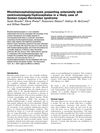Gomez–Lopez-Hernandez Syndrome: Two New Cases and Review of the Literature
December 2008
in “
Pediatric neurology
”
TLDR The document adds two cases of Gomez-Lopez-Hernandez syndrome and suggests including trigeminal anesthesia and scalp alopecia as key diagnostic criteria.
Gomez–Lopez-Hernandez syndrome, also known as cerebellotrigeminal-dermal dysplasia, is a rare neurocutaneous disorder characterized by trigeminal anesthesia, scalp alopecia, and cerebellar anomalies. Additional features include craniosynostosis, short stature, hypertelorism, down-slanting palpebral fissures, corneal opacities, mediofacial hypoplasia, and turri-brachycephaly. The document reported two new cases, bringing the total to 21 documented cases. Both patients, aged 1 and 6 years, exhibited typical features, mild mental retardation, and dyspraxia. MRI findings showed rhombencephalosynapsis, a consistent neuroimaging feature of the syndrome. The authors proposed that the presence of trigeminal anesthesia and/or partial scalp alopecia should be included in the diagnostic criteria for the syndrome.
